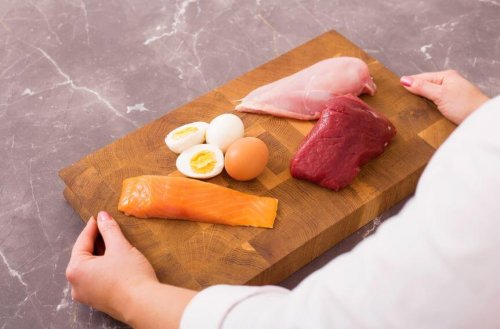Diet and Exercises for Quickly Building Muscle Mass

Working out at the gym without seeing any results is incredibly frustrating. We really get it! So, in today’s post, we’d like to show you some ways to change your diet and improve your exercises to build muscle mass faster. After all, you might be slaving away on gym equipment without realizing that you could get better results by just making a few changes to your routine.
To help you save time and become more motivated, we recommend implementing some dietary changes to complement your work out routines. The right diet and exercise combination will get you on track and give you maximum benefits for all your efforts!
Diet for building muscle mass quickly
There’s no question about it, what you choose to eat is an important part of successfully building muscle mass. In light of this, make sure that you’re including protein and more calories in your diet, among other things, and avoid junk food.
1. Protein
Firstly, you need to know that protein is the fuel that your muscles use to grow. Physical training tears your muscles and the protein rebuilds them. So, consuming protein is a basic block for quick recuperation and it has a key role in muscle growth.

2. More calories
To build muscle faster, you need to give your body more calories to create new muscles. If you’re only consuming the sufficient number of calories to maintain your lean muscle mass, your body won’t have enough resources to create new muscle fiber. Don’t forget that the amount of calories you need depends on your body weight, metabolism and workout intensity.
3. Avoid junk food
Moving on, you need to avoid junk food if you want to build your muscles quickly. Junk food only makes you gain fat, not muscle. This makes it a food that you should exclude from your healthy diet.
4. Hydrate properly
Going to the gym or exercising outdoors without being properly hydrated won’t give you the energy to develop your muscles. Instead, it translates into fighting fatigue, nausea, and headaches. However, when you do drink sufficient water, your body has enough liquids and electrolytes, meaning that it can work efficiently and enjoy better results.
5. Carbohydrates
Lastly, carbohydrates help to restore glycogen levels, which feeds active muscles. Carbohydrates might not be necessary for stimulating muscle growth, but they’re really important for workouts. So, make sure you eat the right kinds of carbohydrates, such as pumpkin, sweet potatoes or brown rice.
“Excellence is not a singular act, but a habit. You are what you do repeatedly.”
-Shaquille O’Neal-
Exercises to quickly build muscle mass
Building new muscles means that you have to tear the original muscle fibers. Advanced resistance training is the best way to go, which means that you’ll need to start including some weight-lifting in your work out plan. For your benefit, we’ve gathered a list with some exercises that can help you quickly gain muscle mass:
1. Reduce the number of repetitions in each set
Firstly, we suggest reducing the number of repetitions in each set. This is essential for hypertrophy.

2. Increase weight
Secondly, if you want to increase your muscle mass, you need to increase the weights that you’re lifting. Increase your weights slowly by adding more each week. You’ll probably notice your muscles growing with every weight increase!
3. Ripping muscle
Lastly, tearing muscle fibers is synonymous to building muscle mass. So, if you’re feeling the burn the day after your workout, you should be content, because it’s a good sign! The torn muscle tissue reacts by temporarily swelling, and it releases a signal, telling the body to build more muscle.
To recap what you’ve read, diet and exercise are essential for quickly building more muscle mass. Above all, stay motivated because we know that you can reach your goals if you keep following our advice!
Working out at the gym without seeing any results is incredibly frustrating. We really get it! So, in today’s post, we’d like to show you some ways to change your diet and improve your exercises to build muscle mass faster. After all, you might be slaving away on gym equipment without realizing that you could get better results by just making a few changes to your routine.
To help you save time and become more motivated, we recommend implementing some dietary changes to complement your work out routines. The right diet and exercise combination will get you on track and give you maximum benefits for all your efforts!
Diet for building muscle mass quickly
There’s no question about it, what you choose to eat is an important part of successfully building muscle mass. In light of this, make sure that you’re including protein and more calories in your diet, among other things, and avoid junk food.
1. Protein
Firstly, you need to know that protein is the fuel that your muscles use to grow. Physical training tears your muscles and the protein rebuilds them. So, consuming protein is a basic block for quick recuperation and it has a key role in muscle growth.

2. More calories
To build muscle faster, you need to give your body more calories to create new muscles. If you’re only consuming the sufficient number of calories to maintain your lean muscle mass, your body won’t have enough resources to create new muscle fiber. Don’t forget that the amount of calories you need depends on your body weight, metabolism and workout intensity.
3. Avoid junk food
Moving on, you need to avoid junk food if you want to build your muscles quickly. Junk food only makes you gain fat, not muscle. This makes it a food that you should exclude from your healthy diet.
4. Hydrate properly
Going to the gym or exercising outdoors without being properly hydrated won’t give you the energy to develop your muscles. Instead, it translates into fighting fatigue, nausea, and headaches. However, when you do drink sufficient water, your body has enough liquids and electrolytes, meaning that it can work efficiently and enjoy better results.
5. Carbohydrates
Lastly, carbohydrates help to restore glycogen levels, which feeds active muscles. Carbohydrates might not be necessary for stimulating muscle growth, but they’re really important for workouts. So, make sure you eat the right kinds of carbohydrates, such as pumpkin, sweet potatoes or brown rice.
“Excellence is not a singular act, but a habit. You are what you do repeatedly.”
-Shaquille O’Neal-
Exercises to quickly build muscle mass
Building new muscles means that you have to tear the original muscle fibers. Advanced resistance training is the best way to go, which means that you’ll need to start including some weight-lifting in your work out plan. For your benefit, we’ve gathered a list with some exercises that can help you quickly gain muscle mass:
1. Reduce the number of repetitions in each set
Firstly, we suggest reducing the number of repetitions in each set. This is essential for hypertrophy.

2. Increase weight
Secondly, if you want to increase your muscle mass, you need to increase the weights that you’re lifting. Increase your weights slowly by adding more each week. You’ll probably notice your muscles growing with every weight increase!
3. Ripping muscle
Lastly, tearing muscle fibers is synonymous to building muscle mass. So, if you’re feeling the burn the day after your workout, you should be content, because it’s a good sign! The torn muscle tissue reacts by temporarily swelling, and it releases a signal, telling the body to build more muscle.
To recap what you’ve read, diet and exercise are essential for quickly building more muscle mass. Above all, stay motivated because we know that you can reach your goals if you keep following our advice!
All cited sources were thoroughly reviewed by our team to ensure their quality, reliability, currency, and validity. The bibliography of this article was considered reliable and of academic or scientific accuracy.
- Egan, B. (2016). Protein intake for athletes and active adults: Current concepts and controversies. Nutrition bulletin, 41(3), 202-213. Recuperado de: https://onlinelibrary.wiley.com/doi/full/10.1111/nbu.12215
- Rogerson, D. (2017). Vegan diets: practical advice for athletes and exercisers. Journal of the International Society of Sports Nutrition, 14(1). Recuperado de: https://www.tandfonline.com/doi/full/10.1186/s12970-017-0192-9
- González-Gross, M., Gutiérrez, Á. J., Mesa, J. L., Ruiz-Ruiz, J., & Castillo, M. J. (2001). La nutrición en la práctica deportiva: Adaptación de la pirámide nutricional a las características de la dieta del deportista. Archivos Latinoamericanos De Nutricion, 51(4), 321-331. Recuperado de: http://ve.scielo.org/scielo.php?script=sci_arttext&pid=S0004-06222001000400001
- Castro-Sepúlveda, M., Cerda-Kohler, H., Pérez-Luco, C., Monsalves, M., Cristobal Andrade, D., Zbinden-Foncea, H., … & Ramírez-Campillo, R. (2015). El estado de hidratación después del ejercicio afecta la tasa metabólica basal y la variabilidad de la frecuencia cardiaca. Nutrición Hospitalaria, 31(3), 1273-1277. Recuperado de: https://scielo.isciii.es/scielo.php?script=sci_arttext&pid=S0212-16112015000300037
- Lorenzo, I., Serra-Prat, M., & Yébenes, J. C. (2019). The role of water homeostasis in muscle function and frailty: A review. Nutrients, 11(8), 1857. Recuperado de: https://www.mdpi.com/2072-6643/11/8/1857
- Carvalho, L., Junior, R. M., Barreira, J., Schoenfeld, B. J., Orazem, J., & Barroso, R. (2022). Muscle hypertrophy and strength gains after resistance training with different volume-matched loads: a systematic review and meta-analysis. Applied Physiology, Nutrition, and Metabolism, 47(4), 357-368. Recuperado de: https://cdnsciencepub.com/doi/abs/10.1139/apnm-2021-0515.
- Haun, C. T., Vann, C. G., Roberts, B. M., Vigotsky, A. D., Schoenfeld, B. J., & Roberts, M. D. (2019). A critical evaluation of the biological construct skeletal muscle hypertrophy: size matters but so does the measurement. Frontiers in physiology, 247. Recuperado de: https://doi.org/10.3389/fphys.2019.00247
- Raya-González, J., & Sánchez, M. C. (2018). Métodos de entrenamiento y aspectos nutricionales para el aumento de la masa muscular: una revisión sistemática. Arch. med. deporte, 376-385. Recuperado de: https://pesquisa.bvsalud.org/portal/resource/pt/ibc-187297
This text is provided for informational purposes only and does not replace consultation with a professional. If in doubt, consult your specialist.








